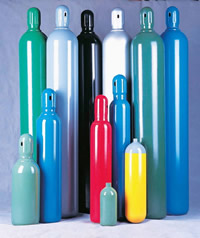Compressed Gas
 According to OSHA Hazard Communication Standard:
According to OSHA Hazard Communication Standard:
“Compressed gas” means:
- A gas or mixture of gases having, in a container, an absolute pressure exceeding 40 psi at 70 deg. F (21.1 deg. C); or
- A gas or mixture of gases having, in a container, an absolute pressure exceeding 104 psi at 130 deg. F (54.4 deg. C) regardless of the pressure at 70 deg. F (21.1 deg. C); or
- A liquid having a vapor pressure exceeding 40 psi at 100 deg. F (37.8 deg. C) as determined by ASTM D-323-72.
Compressed gases can be toxic, flammable, oxidizing, corrosive, or inert. In the event of a leak, inert gases can quickly displace air in a large area creating an oxygen-deficient atmosphere, toxic gases can create poison atmospheres, and flammable or reactive gases can result in fire and exploding cylinders. In addition, there are hazards from the pressure of the gas and the physical weight of the cylinder. A gas cylinder falling over can break containers and crush feet. The cylinder can itself become a missile if the cylinder valve is broken off.
Compressed gases can cause fires, explosions, oxygen deficient atmospheres, toxic gas exposures as well as the innate physical hazard associated with cylinders under high pressure. Special storage, use, handling and disposal procedures are necessary to ensure the safety of researchers using these chemicals and equipment.
The Hazardous Materials Regulations (HMR) regulate the safe and secure transportation of hazardous materials in commerce.
- Accept only properly identified cylinders and do not rely on color codes.
- Wear safety equipment appropriate for the hazard potential of the gas before beginning work.
- If a cylinder or valve is noticeably corroded, the vendor should be contacted for instructions.
- A leaking cylinder should be removed and isolated in a well-ventilated safe area. It may be necessary to call in trained emergency response personnel.
- If the leak is at the junction of the cylinder valve and cylinder DO NOT try to repair! Instead, contact the supplier.
- Properly secure cylinders in a well ventilated and protected area away from heat, flames, and the sun.
- Segregated cylinders by hazard classes while in storage.
- Discontinue use of the cylinder when it has at least 25 psi remaining; close valve to prevent air and moisture from entering. Return unused and empty cylinders to the vendor for reuse or refill.
- Mark or tag empty cylinders “EMPTY”
- All compressed gas cylinders must bear labels that clearly identify the contents. Labels can be found on the Safety Labels and Signage page.
- Compressed gas cylinders must be in an upright position and supported at all times, whether full or empty. Acceptable methods of support include:
- wall-mounted or bench-mounted gas cylinder brackets;
- chains or belts anchored to walls or benches; and,
- free-standing dollies or carts designed for gas cylinders and equipped with safety chains or belts.
- Gas cylinders must have the valve protection cap in place except when in use.
- Use appropriate dollies or hand trucks to move cylinders weighing more than 50 pounds.
- Pressure regulators and gauges must be compatible with the cylinder valves. You may not use “cheaters” (adapters) instead of the correct regulator and gauge.
- Cylinders of dangerous gases, such as ammonia, carbonyl sulfide, hydrogen cyanide, hydrogen sulfide, methylamine, and nitric oxide, must follow the University’s Dangerous Gas Policy.
DO NOT:
- DO NOT purchase more or larger cylinders than necessary;
- DO NOT store flammable gases next to an exit or near oxygen cylinders;
- DO NOT use copper fittings or tubing on acetylene tanks;
- DO NOT use Teflon tape on cylinder or tube fitting connections, which have metal-to-metal face seals or gasket seals;
- DO NOT permit oil or grease to contact cylinders or their valves, especially cylinders containing oxidizing gases.
1910.101(a)
“Inspection of compressed gas cylinders.” Each employer shall determine that compressed gas cylinders under his control are in a safe condition to the extent that this can be determined by visual inspection. Visual and other inspections shall be conducted as prescribed in the Hazardous Materials Regulations of the Department of Transportation (49 CFR parts 171-179 and 14 CFR part 103). Where those regulations are not applicable, visual and other inspections shall be conducted in accordance with Compressed Gas Association Pamphlets C-6-1968 and C-8-1962, which is incorporated by reference as specified in Sec. 1910.6.
1910.101(b)
“Compressed gases.” The in-plant handling, storage, and utilization of all compressed gases in cylinders, portable tanks, rail tank cars, or motor vehicle cargo tanks shall be in accordance with Compressed Gas Association Pamphlet P-1-1965, which is incorporated by reference as specified in Sec. 1910.6.
1910.101(c)
“Safety relief devices for compressed gas containers.” Compressed gas cylinders, portable tanks, and cargo tanks shall have pressure relief devices installed and maintained in accordance with Compressed Gas Association Pamphlets S-1.1-1963 and 1965 addenda and S-1.2-1963, which is incorporated by reference as specified in Sec. 1910.6.
Specific Gases
Associated Departments:
